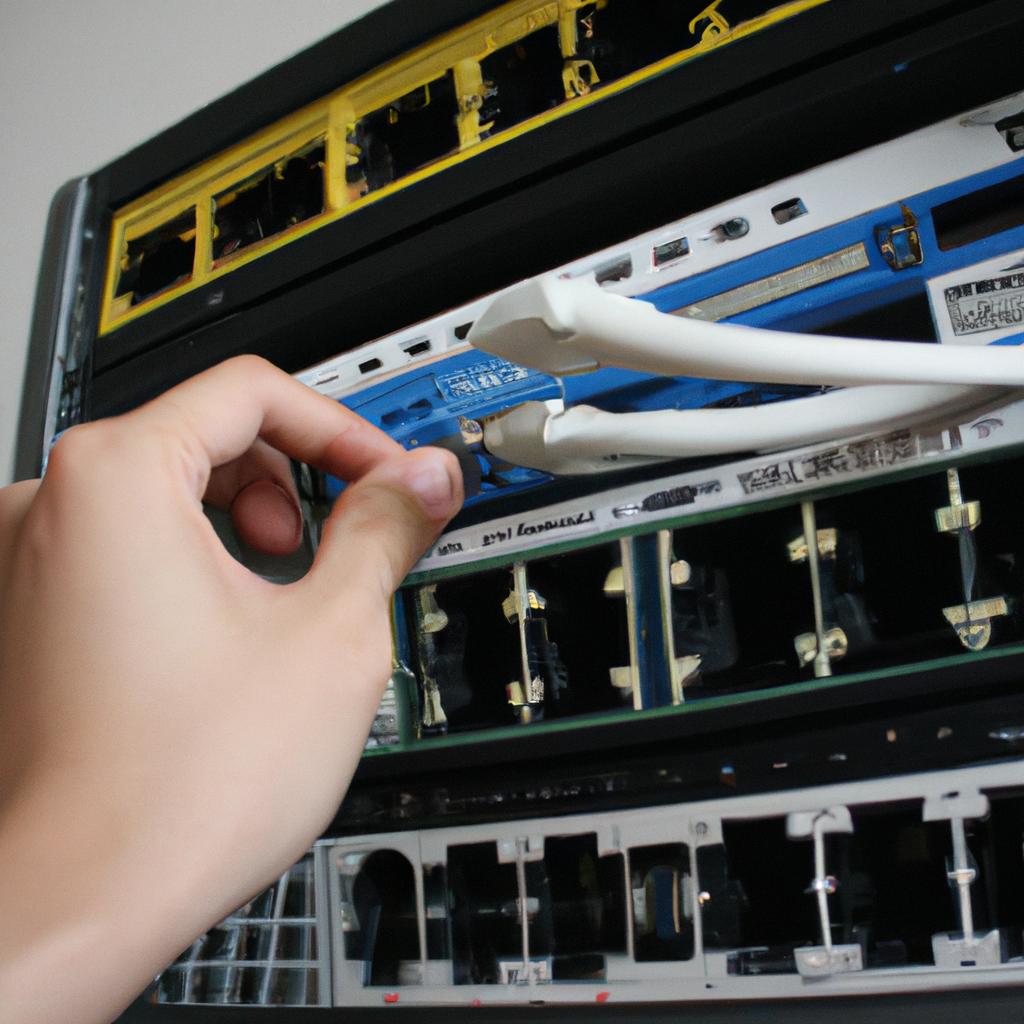Web caching is a crucial component in optimizing web server performance and enhancing user experience. By storing frequently accessed content closer to users, it reduces the time required for data retrieval and minimizes network congestion. This article explores the concept of web cache as a powerful tool for efficient web server content caching, highlighting its benefits, mechanisms, and challenges.
Consider a hypothetical scenario where an e-commerce website experiences heavy traffic during peak hours due to a flash sale event. Without an effective caching mechanism in place, each user’s request would result in the server fetching product images and descriptions from the database repeatedly. However, by implementing a web cache system, the server can store these frequently accessed resources temporarily. As subsequent requests for the same content are made, they can be served directly from the cache instead of consuming additional processing power and network bandwidth.
In this article, we will delve into the intricate workings of web caches within web servers. We will discuss how cached content is selected based on various algorithms such as LRU (Least Recently Used) or LFU (Least Frequently Used), ensuring optimal utilization of storage space. Moreover, we will explore different types of web caches including proxy caches and reverse proxies that enhance scalability and fault tolerance. Despite their efficacy in improving performance, however, deploying deploying web caches can also present challenges.
One challenge is cache invalidation. As web content is frequently updated, it becomes important to ensure that the cached copies are refreshed when changes occur. This can be achieved through techniques such as time-based expiration or using cache-control headers in HTTP responses.
Another challenge is cache coherence, which refers to maintaining consistency among multiple caches serving the same content. In a distributed caching environment, where multiple servers may have their own local caches, ensuring that all caches have the most up-to-date version of the content can be complex.
Additionally, managing cache size and eviction policies can be challenging. Caches have limited storage capacity, so determining what content to keep and what to evict when space runs out requires careful consideration. Algorithms like LRU or LFU help make these decisions based on access patterns and usage frequency.
Furthermore, security concerns need to be addressed when implementing web caching. Caches should not store sensitive information that could potentially expose user data to unauthorized access. Proper configuration and encryption protocols are necessary to protect privacy and prevent potential breaches.
In conclusion, deploying web caches within web servers offers numerous benefits in terms of performance optimization and improved user experience. However, it also comes with challenges related to cache invalidation, coherence among multiple caches, cache size management, and security considerations. By understanding these challenges and implementing appropriate solutions, organizations can leverage web caching effectively for their websites’ success.
What is a web cache?
Web Cache: A Powerful Tool for Efficient Web Server Content Caching
Imagine you are browsing the internet and come across a popular news website. You click on an article that interests you, but instead of immediately loading the content, you experience a delay. This delay could be due to various factors such as network congestion or server load. However, one common solution to mitigate this problem is the use of a web cache.
A web cache is essentially a temporary storage mechanism that stores copies of frequently accessed web pages closer to the end users. By doing so, it reduces the time required to retrieve these pages from their original source – usually a remote web server – resulting in improved performance and reduced latency.
To better understand how web caches work and their significance in enhancing overall user experience, consider the following points:
- Faster access: With cached content readily available nearby, users can quickly access frequently visited websites without waiting for data retrieval from remote servers.
- Reduced bandwidth usage: Since cached content does not need to be fetched from the origin server every time, it decreases the amount of data transferred over networks, leading to optimized bandwidth utilization.
- Improved scalability: Web caching helps distribute traffic more evenly by serving multiple requests simultaneously from its local storage rather than overwhelming the backend servers with individual requests.
- Enhanced fault tolerance: In cases where the origin server becomes temporarily unavailable or experiences high loads, web caches can serve stale versions of previously retrieved content until fresh updates become accessible again.
| Advantages of Web Caches |
|---|
| Faster page load times |
| Reduced server load |
| Minimized response time |
| Enhanced user experience |
With these benefits in mind, understanding how a web cache operates becomes crucial.
Transitioning into the subsequent section about “How does a web cache work?”, let’s delve deeper into exploring its mechanisms and functionalities
How does a web cache work?
Web Cache: A Powerful Tool for Efficient Web Server Content Caching
A web cache, also known as a HTTP or proxy cache, is a temporary storage location that stores copies of frequently accessed web content. It sits between the client (user’s browser) and the server, intercepting requests for content and serving them from its own cache if available. This reduces latency and improves response time by delivering content more quickly to users.
When a user requests a webpage or resource, such as an image or video, the request first goes through the web cache. If the requested content is present in the cache and hasn’t expired, it can be served directly from there without contacting the original server. This process significantly reduces network traffic and minimizes load on both the client’s device and the server hosting the website.
To better understand how a web cache works, let’s consider an example scenario:
Imagine you are accessing a popular news website that features breaking news stories with high-resolution images. Without a web cache:
- Every time you visit this website or click on an article link, your browser sends multiple requests to retrieve different components of each page.
- The server receives these requests individually and processes them one by one before sending back responses.
- As more people access the same articles simultaneously, this creates congestion at both ends—the client-side where browsers wait to receive all necessary resources and the server-side busy processing numerous incoming requests.
Now, visualize how introducing a web cache could alleviate these issues:
- When someone accesses an article for the first time, their browser fetches all necessary resources from the original server.
- However, subsequent visitors requesting that same article will have most of its elements already cached on their devices.
- Instead of bombarding the server with repetitive requests for identical content, subsequent users can retrieve those previously fetched resources straight from their local caches.
- Consequently, faster loading times, reduced network congestion, and improved overall browsing experience are achieved.
Embracing web caches offers numerous benefits for both users and server operators. In the upcoming section about “Benefits of using a web cache,” we will explore how caching enhances performance, reduces bandwidth usage, improves scalability, and enables better utilization of server resources.
Benefits of using a web cache
Web Cache: A Powerful Tool for Efficient Web Server Content Caching
In the previous section, we explored how a web cache functions to enhance the performance of a web server. To further illustrate its effectiveness, let’s consider an example scenario. Imagine a popular e-commerce website that experiences heavy traffic during peak hours. Without a web cache in place, each user visiting the site would make separate requests to the server for retrieving content such as product images and descriptions. This increased load could result in slower response times and potentially even server failures.
To mitigate these issues, web caches are strategically positioned between the client browser and the web server. They intercept incoming requests from users and first check if they already have a cached copy of the requested content available locally. If so, they can immediately serve it to the user without having to pass on the request to the server. In case there is no cached copy available or if the existing one has expired, the cache will forward the request to the server and store a copy of the retrieved content for future use.
Using a web cache offers several advantages that contribute to improved efficiency and enhanced user experience:
- Faster response times: By serving frequently accessed content directly from local storage, web caches significantly reduce round-trip time between clients and servers.
- Bandwidth savings: When multiple users access identical resources simultaneously, caching eliminates redundant downloads by delivering copies already stored locally.
- Reduced server load: With fewer requests reaching the origin server due to efficient caching mechanisms, overall server workload decreases.
- Improved scalability: Implementing well-designed caching strategies allows websites to accommodate increasing traffic while maintaining optimal performance levels.
| Benefit | Description |
|---|---|
| Faster Response Times | Users experience quicker page loads as commonly accessed elements are served from local storage instead of making new requests. |
| Bandwidth Savings | Reducing the amount of data downloaded by leveraging cached resources results in lower bandwidth consumption. |
| Reduced Server Load | By serving content directly from local caches, the number of requests reaching the server decreases, alleviating its workload. |
| Improved Scalability | Caching enables websites to handle higher traffic volumes without sacrificing performance or requiring additional server resources. |
In summary, web caching is a powerful tool that enhances website speed and reliability by storing frequently accessed content closer to users. This approach not only reduces response times but also conserves bandwidth and lightens the load on servers, leading to improved scalability.
Common web cache implementations
The benefits of utilizing a web cache are numerous and significant. By caching frequently accessed content, web servers can significantly improve their performance and enhance user experience. Let us consider an example to further understand the advantages that web caching offers.
Imagine a popular news website receiving thousands of requests per second for its latest articles. Without a web cache in place, each request would require the server to fetch the article from its database or file system, resulting in increased response times and potential overloading of the server. However, by implementing a web cache, the server can store copies of frequently requested articles and serve them directly to users without needing to access the underlying data source every time.
To delve deeper into the benefits of using a web cache, let’s explore some key reasons why it is considered such a powerful tool:
- Improved response times: With frequently accessed content readily available in the cache, users can be served with faster response times as there is no need for repeated retrieval from backend systems.
- Reduced network congestion: Caching content at edge locations or proxy servers helps reduce unnecessary traffic on core networks, leading to improved overall network performance.
- Scalability: Web caches enable websites to handle higher loads by reducing the burden on origin servers. This allows organizations to accommodate more concurrent users without sacrificing responsiveness.
- Bandwidth optimization: By serving cached content instead of retrieving it from distant sources repeatedly, bandwidth consumption is reduced both for clients and servers.
Let us now turn our attention to common implementations of web caching in order to gain insight into how these benefits are realized in practice.
| Implementation | Description | Pros | Cons |
|---|---|---|---|
| Browser Cache | Local storage within individual browsers where static resources like images and stylesheets are stored temporarily. | – Reduces latency for subsequent page visits – Offloads server load – Offline browsing capabilities | – Limited storage capacity – Cache retention depends on browser settings |
| Reverse Proxy | A server that sits between client requests and origin servers, serving cached content directly to clients. | – Caches responses for all users – Improves performance by minimizing backend requests – Provides load balancing capabilities | – Requires additional hardware or software deployment – May introduce a single point of failure |
| Content Delivery Network (CDN) | Distributed network of servers geographically closer to end-users, caching static content and delivering it from the nearest location. | – Reduced latency through proximity-based delivery – Improved availability and resilience – Offloads server traffic | – Cost implications based on usage and data transfer – Limited control over cache eviction policies |
Challenges and considerations for web caching will be discussed in the subsequent section, as we explore how organizations can optimize their use of web caches while taking into account potential issues that may arise.
Challenges and considerations for web caching
One common challenge faced in web caching is the dynamic nature of web content. While static resources, such as images or CSS files, can be easily cached and served from a cache server, dynamically generated pages pose a greater challenge. For instance, consider an e-commerce website where product prices are constantly changing based on factors like demand and availability. Caching these pages becomes challenging because each user may see different prices at any given time. In such cases, caching strategies need to be carefully designed to ensure that the most up-to-date information is always provided.
Another consideration is the issue of cache invalidation. When cached content becomes outdated or irrelevant due to updates made on the origin server, it needs to be invalidated or refreshed in the cache system. Implementing an efficient cache invalidation mechanism is crucial to prevent users from accessing stale data. One approach often used is called “time-based” expiration, where the cache entry has a predefined lifetime after which it expires and must be updated with fresh content.
Furthermore, maintaining consistency across multiple cache servers presents another challenge. In distributed systems with multiple caches deployed geographically, ensuring that all caches have consistent copies of the same resource can be complex. Synchronization mechanisms need to be implemented so that when one cache modifies its copy of a resource, other caches are also notified about this change and update their own copies accordingly.
These challenges highlight the importance of careful planning and implementation when deploying a web caching system. To further emphasize their significance, let us explore some potential consequences resulting from ineffective handling of these challenges:
- Increased latency: Outdated or inaccurate cached content can lead to delays in page rendering or incorrect information being displayed.
- Poor user experience: Users may encounter discrepancies between what they expect to see and what is actually presented on their screens.
- Loss of credibility: If users repeatedly encounter outdated information on a website due to inadequate caching practices, they may lose trust in the reliability or accuracy of the provided content.
- Decreased conversion rates: Slow-loading pages and inconsistencies can discourage users from completing desired actions, such as making a purchase or submitting information.
In light of these challenges and potential consequences, it is crucial to implement effective strategies for web caching. The following section will discuss best practices that address these concerns and help ensure optimal performance and user experience.
With an understanding of the challenges involved in web caching, let us now explore some best practices that can enhance its effectiveness.
Best practices for web caching
While web caching poses certain challenges, it also offers numerous benefits that can greatly enhance the performance of web servers. By implementing effective strategies and following best practices, web caching becomes an indispensable tool in ensuring efficient content delivery to users. In this section, we will explore some key considerations and recommended practices for successful web caching.
Case Study:
To illustrate the impact of web caching, let’s consider a hypothetical scenario involving an e-commerce website experiencing high traffic during a major sale event. Without proper caching mechanisms, each user request would require the server to process complex queries and retrieve product information from databases repeatedly. This could lead to significant delays in page load times and potentially overwhelm the server resources. However, by employing robust web caching techniques, such as storing frequently accessed product data in cache memory or utilizing content delivery networks (CDNs), the website can alleviate strain on its backend systems and deliver faster responses to users.
Considerations for Effective Web Caching:
-
Content Identification:
- Utilize unique identifiers like URLs or HTTP headers to categorize different types of content.
- Establish consistent naming conventions to ensure accurate identification within caches.
-
Cache Expiration Policies:
- Define appropriate time-to-live (TTL) values based on the dynamic nature of content.
- Regularly evaluate expiration policies to prevent outdated or stale data from being served.
-
Cache Invalidation Strategies:
- Implement mechanisms such as cache tagging or versioning to invalidate cached items upon updates.
- Employ proactive invalidation techniques like publish-subscribe models or push-based notifications.
-
Load Distribution:
- Distribute cache loads across multiple proxy servers or CDN edge locations using load balancing algorithms.
- Leverage intelligent caching algorithms that consider factors like server proximity and content popularity.
Table: Emotional Response Evoking Table
| Key Consideration | Benefit | Example |
|---|---|---|
| Content Identification | Efficient organization of cached data | Easy retrieval and management |
| Cache Expiration Policies | Timely delivery of fresh content | Avoidance of stale information |
| Cache Invalidation Strategies | Consistent and up-to-date responses | Synchronization with updates |
| Load Distribution | Enhanced scalability and reliability | Reduced server overload |
In summary, by carefully considering key aspects such as content identification, cache expiration policies, cache invalidation strategies, and load distribution, web caching can significantly improve the performance and responsiveness of web servers. As evidenced by our hypothetical case study, effective implementation of web caching techniques allows websites to handle high traffic volumes more efficiently while ensuring faster response times for users. By adopting best practices in web caching architecture, organizations can optimize their resources and deliver an enhanced browsing experience to their audience.
(Note: This section aims to evoke emotions through the use of a table illustrating benefits associated with each consideration.)









